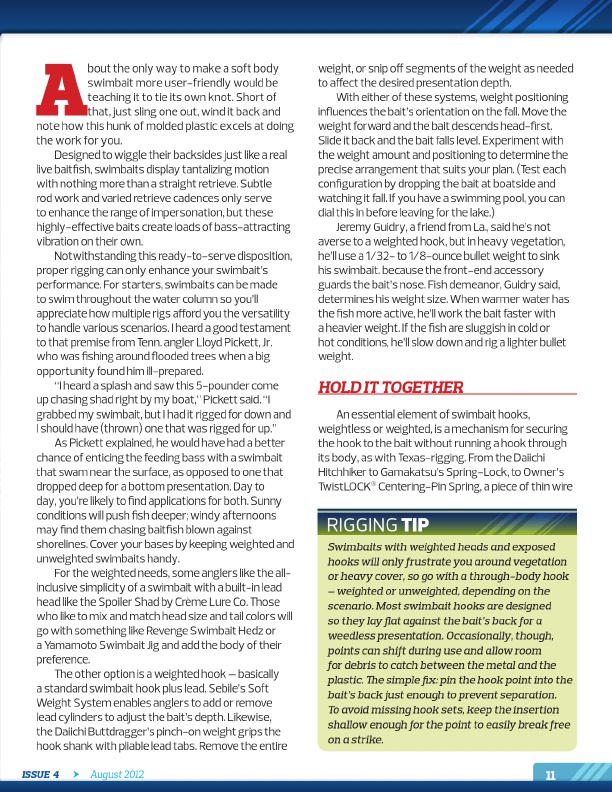
A
bout the only way to make a soft body swimbait more user-friendly would be teaching it to tie its own knot. Short of that, just sling one out, wind it back and note how this hunk of molded plastic excels at doing the work for you. designed to wiggle their backsides just like a real live baitfish, swimbaits display tantalizing motion with nothing more than a straight retrieve. Subtle rod work and varied retrieve cadences only serve to enhance the range of impersonation, but these highly-effective baits create loads of bass-attracting vibration on their own. notwithstanding this ready-to-serve disposition, proper rigging can only enhance your swimbait’s performance. For starters, swimbaits can be made to swim throughout the water column so you’ll appreciate how multiple rigs afford you the versatility to handle various scenarios. i heard a good testament to that premise from tenn. angler lloyd Pickett, Jr. who was fishing around flooded trees when a big opportunity found him ill-prepared. “i heard a splash and saw this 5-pounder come up chasing shad right by my boat,” Pickett said. “i grabbed my swimbait, but i had it rigged for down and i should have (thrown) one that was rigged for up.” as Pickett explained, he would have had a better chance of enticing the feeding bass with a swimbait that swam near the surface, as opposed to one that dropped deep for a bottom presentation. day to day, you’re likely to find applications for both. Sunny conditions will push fish deeper; windy afternoons may find them chasing baitfish blown against shorelines. Cover your bases by keeping weighted and unweighted swimbaits handy. For the weighted needs, some anglers like the all- inclusive simplicity of a swimbait with a built-in lead head like the Spoiler Shad by Crème lure Co. Those who like to mix and match head size and tail colors will go with something like revenge Swimbait Hedz or a Yamamoto Swimbait Jig and add the body of their preference. The other option is a weighted hook – basically a standard swimbait hook plus lead. Sebile’s Soft Weight System enables anglers to add or remove lead cylinders to adjust the bait’s depth. likewise, the daiichi Buttdragger’s pinch-on weight grips the hook shank with pliable lead tabs. remove the entire
August 2012
weight, or snip off segments of the weight as needed to affect the desired presentation depth. With either of these systems, weight positioning influences the bait’s orientation on the fall. Move the weight forward and the bait descends head-first. Slide it back and the bait falls level. experiment with the weight amount and positioning to determine the precise arrangement that suits your plan. (test each configuration by dropping the bait at boatside and watching it fall. if you have a swimming pool, you can dial this in before leaving for the lake.) Jeremy Guidry, a friend from la., said he’s not averse to a weighted hook, but in heavy vegetation, he’ll use a 1/32- to 1/8-ounce bullet weight to sink his swimbait. because the front-end accessory guards the bait’s nose. Fish demeanor, Guidry said, determines his weight size. When warmer water has the fish more active, he’ll work the bait faster with a heavier weight. if the fish are sluggish in cold or hot conditions, he’ll slow down and rig a lighter bullet weight.
HOLD IT TOGETHER
an essential element of swimbait hooks, weightless or weighted, is a mechanism for securing the hook to the bait without running a hook through its body, as with texas-rigging. From the daiichi Hitchhiker to Gamakatsu’s Spring-lock, to owner’s twistloCK ® Centering-Pin Spring, a piece of thin wire
riGGinG tIp
Swimbaits with weighted heads and exposed hooks will only frustrate you around vegetation or heavy cover, so go with a through-body hook – weighted or unweighted, depending on the scenario. Most swimbait hooks are designed so they lay flat against the bait’s back for a weedless presentation. Occasionally, though, points can shift during use and allow room for debris to catch between the metal and the plastic. The simple fix: pin the hook point into the bait’s back just enough to prevent separation. To avoid missing hook sets, keep the insertion shallow enough for the point to easily break free on a strike.
Issue 4
11